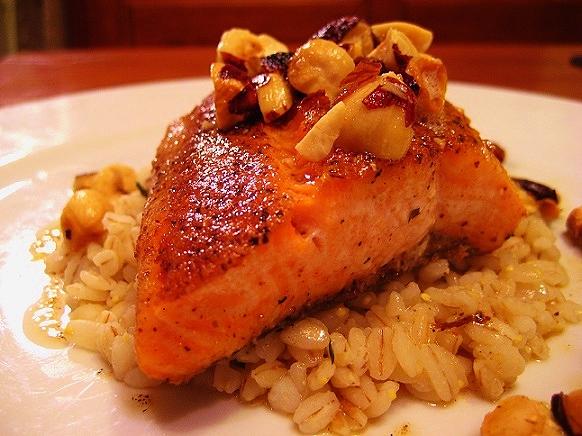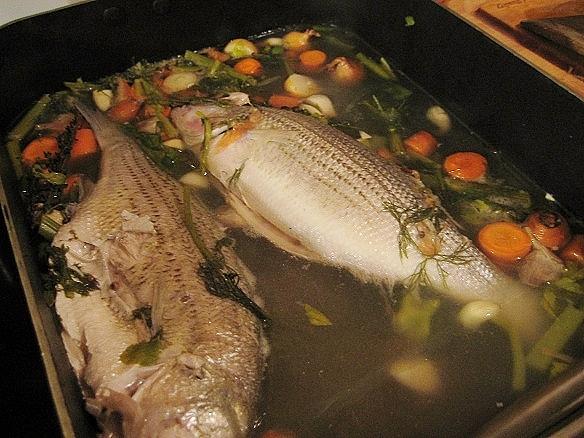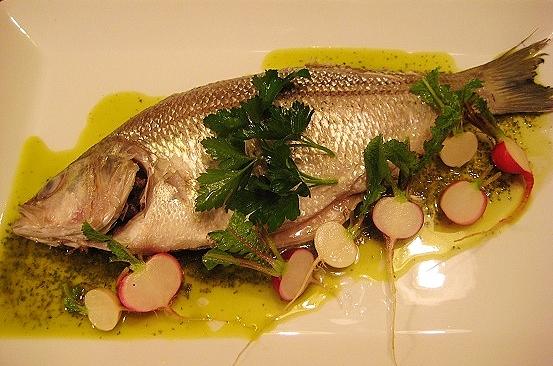-
Posts
5,035 -
Joined
-
Last visited
Content Type
Profiles
Forums
Store
Help Articles
Everything posted by David Ross
-
I'm still trying to figure out why Carla was so giddy over Paula Deen. Really?
-
Delicious!
-
For years when I dined in a fine restaurant I eschewed the very thought of forking over any amount of money for what I considered to be a frivolous expense--a bottle of water. I suppose my naivete was based on the thought that all water that comes out of a tap in any city is decent enough to be served in a restaurant, (I mean, we drink it at home don't we?), so why pay for the bottled stuff? I became very familiar with what I called the "Las Vegas Bottled Water Ruse" during my frequent trips to Nevada. During my first trips to Las Vegas, I readily accepted the waiter's offer of a bottle of water. Even more tempting was the consideration that I was given a choice between "still" or carbonated water. (I've come to question this silly definition of water that is "still." As opposed to water that is "sloshy?"). I quickly became aware of the Las Vegas Ruse when I actually read the bill that came at the end of one dinner and realized that I had been charged $15.00 for a bottle of water. Delivered to the table. Poured into a glass. No ice. Placed on a coaster on the table. $15.00. I went a number of years before I would again even consider ordering a bottle of water at a restaurant. Leave the ruse to be played on the other unsuspecting diners I thought. My defense was to boldly tell the waiter that I would rather have a nice glass of "Clark County" water on ice with a slice of lemon. That'll show them I thought. But my poor judgement quickly caught up with me. The water that is drawn from the tap in Clark County, Nevada, is horrific--fully of minerals yet flat tasting. Awful. And a thin little slice of lemon won't help it. It was at that point that I realized I shouldn't ruin a $150 meal on the taste of bad tap water. If I was spending that much money to enjoy a meal, why destroy the experience and the food with water that tasted like a copper pot. Now I gladly welcome a bottle of water ("still" is still my preference), the moment I'm seated in one of the fine-dining venues in Las Vegas. Yes, the markup is still ridiculous. A bottle of Fiji water selling for $5 bucks in the grocery store is upwards of $15 or more--but it's worth it in Las Vegas. Now when I'm dining in Portland, Oregon, I won't even consider a bottle of water. I grew up drinking the wonderfully clear, crisp water that runs down to Portland off the resevoir up on the flanks of Mount Hood. So I'm informed enough about Portland that I won't order a bottle of water in a restaurant in the Rose City. So what do you think about bottled water service at restaurants? Do you think that a glass of bad tap water can ruin the flavors of the food? Do you order bottled water in a city where you know the tap water is poor, yet you'll stick with the city's best water if you're familiar with the source?
-
Tonight I'm going to be making some deep-fried squid--but I won't be using the old standby all-purpose flour for dredging the squid. Rather than plain flour, I'll be using a blend of rice flour and constarch. Rice flour adds both flavor and texture to deep-fried dishes and cornstarch adds an incredibly crunchy texture to fried food. For onion rings, I typically use a fry mix made locally that is a blend of flour, cornstarch, baking powder and spices. When I deep-fry fish I typically use flour and cornstarch for a crispy crust, but I'll leave out the baking powder because I don't want a cake-like crust. Someday I might experiment with using potato flour as the dredging base for deep-frying, but I'm not sure how potato flour would react in hot oil. What types of flours or mixtures of flours do you like to use when you are deep-frying?
-
I couldn't agree more Heidi. In fact, in the past week I've pulled "Russian Cooking" and "The Cooking of Vienna's Empire" off the shelf to go through them for ideas. Among the many pleasures of having a full 23-volume set of Time-Life's Foods of the World is going back in time to when the books debuted in the 1960's. Cooking back then was incredibly regional throughout the world, and for many people, the books were the only window they had to learn about the cooking and foodstuffs of far-off lands. Certainly society hadn't gotten to the point of global travel where people had the opportunity to taste foods in their native lands, nor did we see exotic ingredients in our markets like lemongrass. Sushi, (The Cooking of Japan), was truly a foreign thought to many Americans at the time the books were published. And unless you lived in a large urban area with European communities, the only Sachertorte you ever saw was in a color photo out of the aforementioned Cooking of Vienna's Empire. As I glance through the pages today, I realize how far we've come. So many wonderful ingredients that were hard to find back then are now at our fingertips and the world's cuisines aren't necessarily defined by borders today. Yet on the other hand, the Foods of the World series remind us as to the roots of regional cuisines and their importance in defining how we eat today.
-
I've never made Shrimp and Grits. Don't know why because I've always thought it looked and sounded like a delicious dish. Regarding the shrimp, does it matter what size of shrimp you use? For the shrimp and grits cooks out there, do you notice a difference in the dish in terms of texture or flavor if you use small shrimp as opposed to the more larger sizes? Finally, is it acceptable to grill the shrimp on an outdoor barbecue grill to get some char on them before combining them with the grits?
-
I've been doing a lot of fish dishes recently and experimenting with techniques I haven't tried much before. Last weekend I did a whole Striped Bass, poached in a court bouillion and served with "Anchoiade" (anchovy garlic sauce) and Radishes. We've been discussing how to poach whole fish here. Poached Striped Bass with Anchoiade and Radishes-
-
So is the "Dude, Sweet," moniker have some sort of meaning for the owners or is it just a catchy name they came up with. I think of "Dude" and chocolates in Texas and I'm not sure I see the link over to the style of confections they offer. So tell me more about the toffee "Fungus Amoungus." Did you try it? I'm wondering about the flavor mixing of porcini with chocolate.
-
-
Deliciously moist and tender with a clean flavor. The radishes were just a last minute idea--saw them in the market and thought they would add a bit of pepper flavor and crunch to accent the fish. I forgot to mention in the first post that I added some dried red pepper flakes to the Anchoiade. It was a nice salty and spicy accent to the Striped Bass. Really turned out to be a nice dish.
-
The beef at the Spokane locale is in fact incredibly beefy and juicy, albeit a bit over-cooked which I think is the downfall of fast-food burger chains that are scared by the Health Department to cook a burger medium-rare. I found the portion of fries generous, and they had a lot of potato flavor. I did give them high marks for using local Russet potatoes harvested within an hour drive of Spokane. But...the large portion and true flavor didn't help overcome the fact the fries were limp and a bit soggy, not crisp with a soft potato pillow inside like I like them. They served the fries with the skin on which added to the flavor. The bun was out of a bag and could have supported the burger and juices better had it been toasted. Would I go back? Probably not. I've found a few locally-owned Mom and Pop burger joints far better and cheaper.
-
A wise, (sensible is actually a more appropriate description), French Chef of note once told me that fish should be cooked in the environment in which it lived. In other words, poached in liquid whether it be water, salt water, stock or a "court bouillion." He went on to instruct that only whole fish (fresh, on the bone, skin on), should be poached in order to maximize the benefits of the technique-incredibly moist, tender fish that is the essence of the waters in which the fish swam. Of course, the first and most important consideration is to find the freshest of fish for poaching. Last week I bought some frozen Sea Bass at the local Asian market. Sometimes frozen seafood in Asian markets is of questionable quality. I've often wondered who would buy a whole fish, guts included, stuffed into a plastic bag that isn't fully sealed or vacuum-packed to preserve it from the depths of the freezer. When a dried out, frozen fish tail is sticking out of a bag, you know it probably won't taste good. For whatever reason, the urge to buy a whole fish overtook my sensibilities last week and I bought a whole frozen sea bass to poach. It wasn't the dried out skeleton of the other fish in the freezer and it looked and smelled decent when I thawed it. But after the sea bass was poached, it literally turned into a soft, gooey mess that had no texture and little flavor. I don't have the evidence to support my claim, but I tend to think the fish suffered from a combination of problems--it was frozen which dried the poor devil out and littered the flesh with ice. Leaving the guts in the sea bass furthered polluted the flavor. I wasn't going to give up on poaching a whole fish after last week's disaster. I set off to Costco yesterday with a mission of buying whole trout to poach. What I found were fresh, whole, farm-raised Striped Bass on ice. I didn't wince that the Striped Bass was farm-raised and set back home with two of the beauties in tow. I don't have a pan specifically made for poaching fish, but I don't think that's an equipment requirement. I use a large roasting pan that is large enough to allow the whole fish to rest flat without having to turn it into a shape to fit a pot. I've poached fish filets in olive oil in the oven, but I didn't think that buying enough olive oil to poach a whole fish would be worth the cost so I settled on a traditional French "court boullion" for the poaching liquid. The court boullion included carrots, onions, celery, garlic, fennel, thyme, marjoram (to add a delicate perfume to the broth) and white peppercorns sauteed in olive oil. I then deglazed the pan with Aquavit, (a nod to the Norwegians. Pernod would have been more in keeping with the French traditon). I used both water and an Italian white wine blend for the liquid. I gently placed the whole Striped Bass in the simmering poaching liquid and left them undisturbed while they poached. They weren't fully submerged in the liquid, but no worries, I simply spooned the hot poaching liquid over the fish. The cooking process for these Striped Bass took about 20 minutes. I served the Striped Bass with radishes and "Anchoiade"-garlicky anchovy sauce. The anchoiade is a mixture of anchovies, parsley, basil, garlic, lemon juice, olive oil, pepper and capers. Poaching whole fish is very easy, but the most impressive aspect of poaching a whole fish is when you bring it to the table. Poached Striped Bass with "Anchoiade" and Radishes-
-
Recently we've been talking about the used of Dried Ingredients in Chinese Cooking. Yet there is another category of ingredients that I've recently started exploring that are just as integral to Chinese cooking-fermented and preserved ingredients. (Some ingredients are simply dried, while others are fermented or preserved. Further, some ingredients may be dried and fermented or preserved). In America we seem to place our primary focus on ingredients that are fresh, fresh, fresh. And while the emphasis on freshness is certainly admirable, at the same time we seem to have forgotten the endless possibilities that fermented and preserved ingredients can lend to a wide variety of dishes. One of my favorite dried ingredients for Chinese style dishes are fermented black beans. I like the salty tang that fermented black beans lend to stir-fries. They seem to accent the flavor of soy while at the same time presenting a hint of exotic smoke. Fermented black beans are incredibly easy to use. Some people recommend rinsing them in water to shed off some of the salt before adding them to a dish. I actually prefer the flavor of fermented black beans full on--I don't rinse them and simply mash some of the beans with a fork before adding them to the wok with some whole beans. A very easy dish to make using black beans is a simple stir-fry of chicken garnished with Chinese celery and cashews. To start, I marinate strips of chicken breast in Chinese rice wine, cornstarch, soy sauce and sesame oil. After a quick stir-fry in a hot wok, I add some ginger and garlic, then the mashed and whole fermented black beans. Once the chicken is done, I add diced celery and cashews. (I like to add the celery at the end of the stir-fry so that it stays crisp). The sauce is simply the same mixture as the chicken marinade-Chinese rice wine, soy sauce, sesame oil and then a cornstarch and water slurry to thicken everything up. Stir-Fried Chicken with Fermented Black Beans, Chinese Celery and Cashews- What types of fermented and preserved ingredients do you use in your Chinese dishes?
-
The 2011 James Beard Award Nominess for Chefs, Restaurants and Restaurant categories have been announced. The 2011 Journalism Aware nominees will be announced in Portland, Oregon, on March 21. Your thoughts on the nominees? Read the list here.
-

eG Foodblog: lesliec (2011) - Beef, boots and other stories
David Ross replied to a topic in Food Traditions & Culture
Really enjoying this delicious ride and your photos. -
Such wasted talent on silly "challenges." Sometimes a season of Top Chef (or derivative thereof), presents us with a third-rate stable of cooks and interesting challenges, or, as we have here, a bevy of talent being wasted on innocuous games.
-

In This Economy, I'm Sadly Doing Without...: 2011 Version
David Ross replied to a topic in Food Traditions & Culture
I've slashed a lot of household expenses, including the newspaper and cut the cable bill in half. And I've cut back in the kitchen on two things I ALWAYS used to keep on hand: a bottle of saffron and a bottle of vanilla beans. I'm not doing really any cooking with saffron now and I only buy vanilla beans on a rare occasion when I make say vanilla ice cream. It's hard right now to justify the costs, although the flavors would be worth it. -
That sounds really refreshing. I think I'll start making Huckleberry Vodka Martini's!
-

What's the Skankiest Part of Your Kitchen?
David Ross replied to a topic in Food Traditions & Culture
The floor level cupboard I forgot about where I had stored a trash can--full of kitchen garbage. It didn't smell, but a few months later I happened to open the cupboard, forgetting what was in there. There was literally a large green plant spear, with leaves, growing out of the garbage can. It was like something growing out of a body in Aliens. I did not attempt to determine which piece of garbage had been the planting seed for the evil weed. To this day it makes me feel ill to think about how long that stew was brewing in that cupboard. -
I do the same thing. Have all kinds of oven mitts and gloves rated to protect one from intense heat but they just sit in a drawer and don't get used. I use stupid little kitchen towels to open up the oven and dearly pay for it. I tried to take a Cuisinart casserole dish out of the oven the other day--with my bare hands. I was quick enough to pull back and didn't suffer any burns.
-
My preferred vinaigrette is hazelnut oil, pear flavored white balsamic and a teaspoon of Dijon mustard, sea salt and pepper. The hazelnut oil is fairly mild as is the pear balsamic. Both taste and remind me of the pears and hazelnuts from Oregon. I just whisk it by hand in a bowl. It's delicious on a salad of sliced pear, toasted hazelnuts, bleu cheese and greens. I usually only make enough to dress two small salads and don't store it.
-
Yesterday I made waffles using a recipe that is a take on the Cargon Malted Waffle Mix. The key to the recipe is to used malted milk powder and to fold an egg white into the batter to make it light and airy. The malted milk powder gives the waffles a tangy flavor. Sometimes I substitute buttermilk for regular milk in the batter and it adds to the sweet yet sour flavors in the waffles. Crisp on the outside and still fluffy in the center.
-
We all know that commercial kitchens are a hazardous place--Chefs come into contact with intense heat, flames, slippery floors and sharp knives--all during the fury of service. Yet the home kitchen can also be a hazardous workplace albeit on a smaller scale. Today when I was painting my kitchen, I was up on a small ladder. To reach a corner in the ceiling, I stepped on top of a butcher block with a large countertop attached. When I stepped on the countertop, it popped off. I lost my balance and fell to the floor, along with all the kitchen tools on top of the counter. The glass jars I use to hold kitchen tools broke, but luckily I wasn't cut by glass. Unfortunately, I had left my portable deep-fryer on the counter to cool so it was full of cold oil. The deep-fryer went flying, but it helped break my fall. When I collected my oil covered self off the floor, I realized I was sitting on top off the deep-fryer. The fry basket is a horrible tangled mess to say the least. Other than a scrape on my left shoulder and a swollen, bruised, left elbow, I seem to have survived intact. Albeit my back will suffer in coming days. It was sort of funny in a tragic way. Cleaning up a gallon of used fry oil wasn't a pretty sight. While my foible was due to using poor judgement while painting my kitchen, I imagine some of you have suffered similar spills, trips, falls and the like in your kitchen.
-
I miss the demise of the local Hayesville market we went to as kids. We would go there on the days we collected dues from the people on our newspaper route. Back then a lot of customers paid the paperboy direct rather than mailing in their subscription fee. We got a take on the fees plus a few tips from customers. On collection day we'd go to Hayesville market and buy candy and maybe some pepproni sticks and a soda. I remember hanging out in the store and the employees were always glad to see us. They never shooed us away. It was probably about 1970 or 1971. The market closed down about 1985 or so, but the owners relocated to a large, new supermarket down the block. It's an independent, employee-owned local market, but it's a supermarket with a thread of the feel of the old place. I also miss the other local market my Mother used to go to. We started going there when we moved to Salem in 1964 and it closed sometime in the mid-70's. I can't remember the name of the store, but the butcher was Oliver Kuykendall-a good German butcher. He had played football in college in the days when they didn't wear faceguards and he looked like Knute Rockne with his knobby nose. He always had bloodspots and stains on his white apron, always wore a paper white butcher's cap. What stands out in my memory was the fresh ground beef Mother got from Oliver that she fed to our dachshund Snoopy. (Mother served Snoopy a spoon of cottage cheese with his fresh ground beef). Oliver let his customers pay monthly on account. When we went in for a pound of bacon, he simply wrote it up on a paper receipt, gave us a carbon copy and filed the original. Mother would go back down to the store at the end of the month to settle her balance in cash. This was standard practice in local stores going back decades, but sadly, by the 70's I think few stores were left that let customers pay on good faith at the end of the month.









